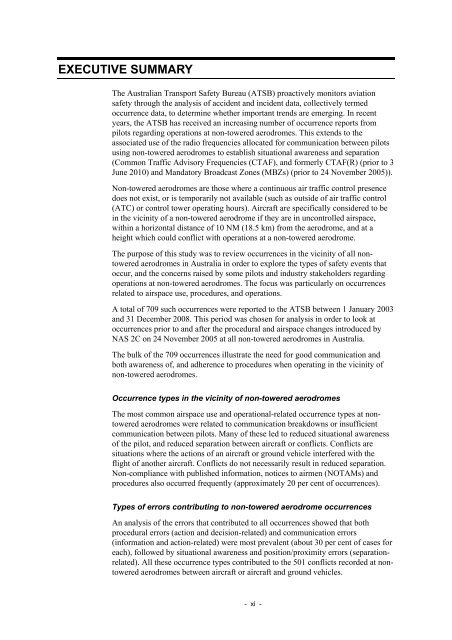Safety in the vicinity of non-towered aerodromes - Australian ...
Safety in the vicinity of non-towered aerodromes - Australian ...
Safety in the vicinity of non-towered aerodromes - Australian ...
You also want an ePaper? Increase the reach of your titles
YUMPU automatically turns print PDFs into web optimized ePapers that Google loves.
EXECUTIVE SUMMARY<br />
The <strong>Australian</strong> Transport <strong>Safety</strong> Bureau (ATSB) proactively monitors aviation<br />
safety through <strong>the</strong> analysis <strong>of</strong> accident and <strong>in</strong>cident data, collectively termed<br />
occurrence data, to determ<strong>in</strong>e whe<strong>the</strong>r important trends are emerg<strong>in</strong>g. In recent<br />
years, <strong>the</strong> ATSB has received an <strong>in</strong>creas<strong>in</strong>g number <strong>of</strong> occurrence reports from<br />
pilots regard<strong>in</strong>g operations at <strong>non</strong>-<strong>towered</strong> <strong>aerodromes</strong>. This extends to <strong>the</strong><br />
associated use <strong>of</strong> <strong>the</strong> radio frequencies allocated for communication between pilots<br />
us<strong>in</strong>g <strong>non</strong>-<strong>towered</strong> <strong>aerodromes</strong> to establish situational awareness and separation<br />
(Common Traffic Advisory Frequencies (CTAF), and formerly CTAF(R) (prior to 3<br />
June 2010) and Mandatory Broadcast Zones (MBZs) (prior to 24 November 2005)).<br />
Non-<strong>towered</strong> <strong>aerodromes</strong> are those where a cont<strong>in</strong>uous air traffic control presence<br />
does not exist, or is temporarily not available (such as outside <strong>of</strong> air traffic control<br />
(ATC) or control tower operat<strong>in</strong>g hours). Aircraft are specifically considered to be<br />
<strong>in</strong> <strong>the</strong> vic<strong>in</strong>ity <strong>of</strong> a <strong>non</strong>-<strong>towered</strong> aerodrome if <strong>the</strong>y are <strong>in</strong> uncontrolled airspace,<br />
with<strong>in</strong> a horizontal distance <strong>of</strong> 10 NM (18.5 km) from <strong>the</strong> aerodrome, and at a<br />
height which could conflict with operations at a <strong>non</strong>-<strong>towered</strong> aerodrome.<br />
The purpose <strong>of</strong> this study was to review occurrences <strong>in</strong> <strong>the</strong> vic<strong>in</strong>ity <strong>of</strong> all <strong>non</strong><strong>towered</strong><br />
<strong>aerodromes</strong> <strong>in</strong> Australia <strong>in</strong> order to explore <strong>the</strong> types <strong>of</strong> safety events that<br />
occur, and <strong>the</strong> concerns raised by some pilots and <strong>in</strong>dustry stakeholders regard<strong>in</strong>g<br />
operations at <strong>non</strong>-<strong>towered</strong> <strong>aerodromes</strong>. The focus was particularly on occurrences<br />
related to airspace use, procedures, and operations.<br />
A total <strong>of</strong> 709 such occurrences were reported to <strong>the</strong> ATSB between 1 January 2003<br />
and 31 December 2008. This period was chosen for analysis <strong>in</strong> order to look at<br />
occurrences prior to and after <strong>the</strong> procedural and airspace changes <strong>in</strong>troduced by<br />
NAS 2C on 24 November 2005 at all <strong>non</strong>-<strong>towered</strong> <strong>aerodromes</strong> <strong>in</strong> Australia.<br />
The bulk <strong>of</strong> <strong>the</strong> 709 occurrences illustrate <strong>the</strong> need for good communication and<br />
both awareness <strong>of</strong>, and adherence to procedures when operat<strong>in</strong>g <strong>in</strong> <strong>the</strong> vic<strong>in</strong>ity <strong>of</strong><br />
<strong>non</strong>-<strong>towered</strong> <strong>aerodromes</strong>.<br />
Occurrence types <strong>in</strong> <strong>the</strong> vic<strong>in</strong>ity <strong>of</strong> <strong>non</strong>-<strong>towered</strong> <strong>aerodromes</strong><br />
The most common airspace use and operational-related occurrence types at <strong>non</strong><strong>towered</strong><br />
<strong>aerodromes</strong> were related to communication breakdowns or <strong>in</strong>sufficient<br />
communication between pilots. Many <strong>of</strong> <strong>the</strong>se led to reduced situational awareness<br />
<strong>of</strong> <strong>the</strong> pilot, and reduced separation between aircraft or conflicts. Conflicts are<br />
situations where <strong>the</strong> actions <strong>of</strong> an aircraft or ground vehicle <strong>in</strong>terfered with <strong>the</strong><br />
flight <strong>of</strong> ano<strong>the</strong>r aircraft. Conflicts do not necessarily result <strong>in</strong> reduced separation.<br />
Non-compliance with published <strong>in</strong>formation, notices to airmen (NOTAMs) and<br />
procedures also occurred frequently (approximately 20 per cent <strong>of</strong> occurrences).<br />
Types <strong>of</strong> errors contribut<strong>in</strong>g to <strong>non</strong>-<strong>towered</strong> aerodrome occurrences<br />
An analysis <strong>of</strong> <strong>the</strong> errors that contributed to all occurrences showed that both<br />
procedural errors (action and decision-related) and communication errors<br />
(<strong>in</strong>formation and action-related) were most prevalent (about 30 per cent <strong>of</strong> cases for<br />
each), followed by situational awareness and position/proximity errors (separationrelated).<br />
All <strong>the</strong>se occurrence types contributed to <strong>the</strong> 501 conflicts recorded at <strong>non</strong><strong>towered</strong><br />
<strong>aerodromes</strong> between aircraft or aircraft and ground vehicles.<br />
- xi -
















